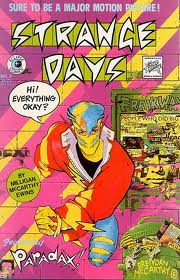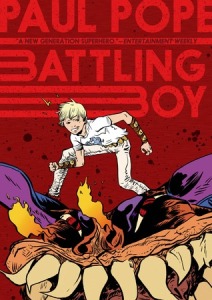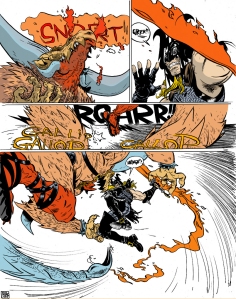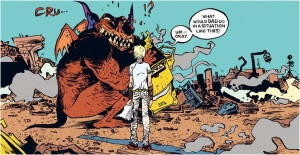I know I promised to do a review of the recently published The Best of Milligan & McCarthy but for a knot of reasons I concluded that devoted fans would know about it and I couldn’t quite jolly myself into pushing it for the merely curious. My first love remained strong, the initial adventure of Paradax, plain-dude taxi driver who comes across a suit that gives him ghost powers (can move through objects, become immaterial, etc.)

If the hippies inspired Underground Comix in the US, the trigger in the UK was punk. Paradax is a media-savvy striver with ripped jeans, a beer habit, a girlfriend that looks like Debbie Harry with a pink Afro — all set in the scuzzy kind of New York that was already disappearing when the comic came out in 1984. Paradax’s first enemy was a warmongering lout named V-2 Pinhead, given to muttering things like “Despicable, soft-bodied, stool-faced liberal! Prepare to feel the Hardness of PINHEAD!” Even Paradax’s catchphrase — “Hi! Everything Okay?” — was perfect for the times.
But he remains stuck in those times. Milligan & McCarthy only completed one more Paradax escapade, and it was much more ordinary, if still wild. Not only is it just too painful to look at the first page of the first Paradax story as the superhero leans on the World Trade Center Towers with the Statue of Liberty in front of them both, but other things had changed by the time the second Paradax tale appeared only three years later. By then the Dark Knight had taken over and ever since, the purported heroes of mainstream comix have been more like V-2 Pinhead.
The rest of The Best of M & M is visually zany a lot of the time — especially inspired to incorporate India-art comix into a psychedelic tale — but too much of it is more fun to breeze through than actually sit and read and tease out what’s supposed to be up. Lots of weird/obscure for the sake of weird/obscure. Some cultural ‘tudes that don’t make it across the Big Pond. But there is that Paradax character — smart design, smart dialog, the Roxy Meets CBGB’s of superheroes.
Speaking of all those neurotic, nasty, all-too-SERIOUS-muderous superheroes that have made mainstream comix geared to adult diehards way more than kids these days, my favorite discovery late in the year was a comic explicitly aimed at kids — Paul Pope’s Battling Boy.

Pope bowled me over with Heavy Liquid in early 2001 (I remember it as my last major glimmer of comix before 9/11), the most vivid and far-reaching dope epic in a comic since the counterculture era (that I know of, anyway). Pope’s storytelling could be a little jagged back then, but at his best he whams home action on the page like Kirby reincarnated and he has this “thing” about lips and teeth that I find endlessly fascinating. Anyway, you do a multi-universe fantasy about a divine-warrior kid who battles monsters with a diverse posse of pals there’s one prime requirement: you gotta draw pretty cool monsters.
Paul Pope draws pretty cool monsters.


PS: I noticed that Pope did a story in an Adventure Time comic (#5), which shows he knows what’s what with animation these days. But like every cartoon-inspired comic not written by Carl Barks, the books are no more than an aside to the show. And indeed, now that I’ve read the Pope story, it’s undeniably more Paul Popey than Adventure Timey.



